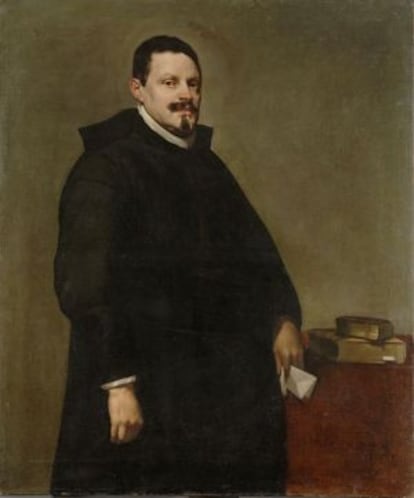'The Inquisitor' ceases to be an unanswered question
A long-lost portrait by Velázquez has been located in Germany in the hands of private collectors

Diego Velázquez completed the portrait of Don Sebastián García de la Huerta, secretary to the Tribunal of the Inquisition, shortly before his first journey to Italy (the least-known period in the Sevillian painter's career). The oil portrait, 121 by 101 centimeters, painted around 1628 and well documented, remained in the hands of the subject's descendants until 1929, when it was sold to an antiquary, and was acquired by a family residing in Latin America. Since then its trail had been lost.
Perfectly conserved and only in need of some cleaning, the discovery of the picture has been announced by Carmen Garrido, the head of the Prado Museum's Technical Documentation section, who is an expert on Velázquez and the author of several works on the painter. Garrido explains the investigation in the latest issue of Ars Magazine. A meticulous technical analysis carried out in the Munich Pinacotheca supports the inclusion of this newly discovered painting in the catalogue of Velázquez works.
Co-author with Jonathan Brown of La técnica de un genio (or, The technique of a genius), Carmen Garrido has no doubt that the gentleman with the disturbing gaze was painted by Velázquez.
I knew it was by Velázquez as soon as I saw it. The strokes are unmistakable"
She adds that two similar portraits were inventoried, one of which disappeared in the Spanish Civil War. This one, which has survived, has remained in private hands, who prefer anonymity, keeping their future intentions close to their chests.
Garrido says that her first contact with the picture was at the request of the owners, in Munich, where the canvas is currently located. "We needed technical evidence, but as soon as I saw the work I knew it was by the hand of Velázquez. The strokes are unmistakable. With one stroke he marks the horizon, but he resolves the head and, above all, the hands, with a few strokes. From a distance, the representation is perfect. Up close, the forms are blurred, as occurs with the Impressionists."
Why did she not resort to The Prado, a museum where she has worked for 35 years? "Because this was the preference of the family, and because in Madrid the process might take forever," the expert explains. "I wrote this study in my free time, and at weekends. It is a lucky chance Velázquez has given me, when I am about to bring my career at the museum to a close."
As to the price the work might fetch at auction, Garrido is cautious, simply pointing out that the painter's preceding work, also a portrait, went for 3.5 million euros.
Tu suscripción se está usando en otro dispositivo
¿Quieres añadir otro usuario a tu suscripción?
Si continúas leyendo en este dispositivo, no se podrá leer en el otro.
FlechaTu suscripción se está usando en otro dispositivo y solo puedes acceder a EL PAÍS desde un dispositivo a la vez.
Si quieres compartir tu cuenta, cambia tu suscripción a la modalidad Premium, así podrás añadir otro usuario. Cada uno accederá con su propia cuenta de email, lo que os permitirá personalizar vuestra experiencia en EL PAÍS.
¿Tienes una suscripción de empresa? Accede aquí para contratar más cuentas.
En el caso de no saber quién está usando tu cuenta, te recomendamos cambiar tu contraseña aquí.
Si decides continuar compartiendo tu cuenta, este mensaje se mostrará en tu dispositivo y en el de la otra persona que está usando tu cuenta de forma indefinida, afectando a tu experiencia de lectura. Puedes consultar aquí los términos y condiciones de la suscripción digital.
Últimas noticias
Most viewed
- Why we lost the habit of sleeping in two segments and how that changed our sense of time
- Trump’s obsession with putting his name on everything is unprecedented in the United States
- Pablo Escobar’s hippos: A serious environmental problem, 40 years on
- The Florida Keys tourist paradise is besieged by immigration agents: ‘We’ve never seen anything like this’
- Charles Dubouloz, mountaineering star, retires at 36 with a farewell tour inspired by Walter Bonatti








































